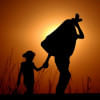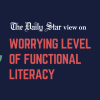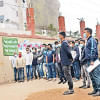Shifting poverty map a wake-up call for policymakers

That economic and climate vulnerabilities are inextricably linked has once again been underscored by the latest Bangladesh Bureau of Statistics (BBS) survey, which ranked Barishal as the poorest division in the country. For long, that spot had been reserved for Rangpur, which was—and still is, to a large extent—synonymous with crippling poverty mostly due to seasonal famines or Monga. However, according to a report based on the Poverty Map 2022, things have turned around for Rangpur where the poverty rate dropped from 47.23 percent in 2016 to 25 percent in 2022. In contrast, Barishal's poverty rate slightly increased from 26.49 percent to 26.6 percent.
The shifting poverty map reflects the changing reality of our policy and geographical landscapes. Rangpur's relative improvement, according to an expert at the BBS event, has been partly driven by the efforts of the government and NGOs in addressing seasonal food insecurity. On the contrary, Barishal's relative deterioration underscores the growing impact of climate change on coastal regions. The division, once known as a food basket, is now struggling with climate vulnerability and its resultant effects, including rising salinity and declining agricultural yields. As a result, many are losing their traditional livelihoods and slipping further into poverty.
Such disparities could only have emerged due to inequitable distribution of budgets, development projects, and economic opportunities. This highlights the need for a more balanced approach to resource allocation, infrastructure development, and economic diversification. Poorer regions also need targeted investments in education, healthcare, and industry to achieve parity with more developed areas.
Another factor contributing to the shift is how wealth and opportunities are being distributed. For example, districts like Noakhali, which now has the lowest poverty rate at 6.1 percent, provide a stark contrast to districts like Madaripur, where poverty stands at 54.4 percent—nearly three times the national average of 18.7 percent. Such disparities could only have emerged due to inequitable distribution of budgets, development projects, and economic opportunities. This highlights the need for a more balanced approach to resource allocation, infrastructure development, and economic diversification. Poorer regions also need targeted investments in education, healthcare, and industry to achieve parity with more developed areas.
That said, we cannot ignore the role likely played by Bangladesh's flawed data governance in shaping or redrawing poverty maps. One can rightly question how Rangpur's poverty rate could have declined so dramatically in just seven years between 2016 and 2022. As it is now abundantly clear, the state data ecosystem was severely compromised during Sheikh Hasina's rule, which often presented flawed and overly optimistic economic indicators, including poverty rates, GDP growth figures, etc. Since data guides policy efforts, flawed statistics likely distorted decision-making, denying crucial interventions to regions that needed them most.
The newly unveiled poverty map seems more grounded in reality and, as such, should serve as a wake-up call for all involved. As one of the poorest and most climate-vulnerable countries, Bangladesh's policymakers must ensure that climate resilience is embedded in poverty alleviation strategies. Similarly, there must be greater efforts to bridge wealth and opportunity gaps among regions to insulate poorer divisions and districts from harsher economic shocks and climate-induced hardships.

 For all latest news, follow The Daily Star's Google News channel.
For all latest news, follow The Daily Star's Google News channel. 








Comments